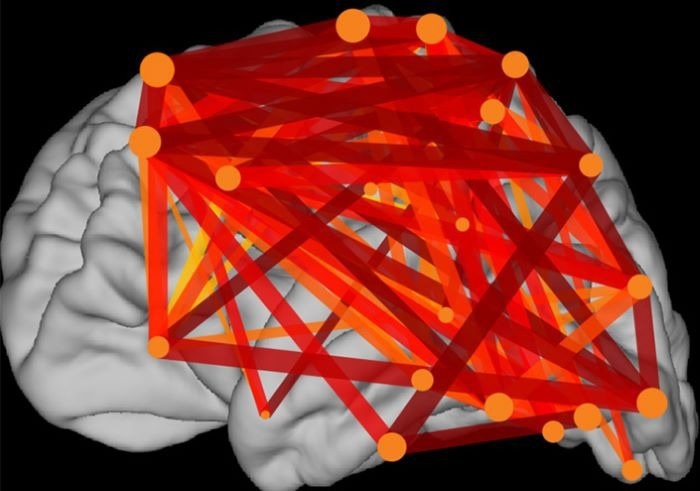For many years, researchers have been concentrating on how the brain organizes information into hierarchical structures, with distinct regions of the brain designated for distinct functions. However, it is still unclear how different domains interact and combine data to create a logical whole.
 The lines on this diagram of the brain represent connections between various areas of the cerebral cortex involved in language processing. When we read, the neurons in these areas fire in precise synchronicity, a phenomenon known as “co-rippling.” Image Credit: UC San Diego Health Sciences
The lines on this diagram of the brain represent connections between various areas of the cerebral cortex involved in language processing. When we read, the neurons in these areas fire in precise synchronicity, a phenomenon known as “co-rippling.” Image Credit: UC San Diego Health Sciences
Now, by monitoring how neurons synchronize throughout the human brain during reading, researchers at the University of California San Diego School of Medicine are one step closer to finding the solution.
Doctorate candidate Jacob Garrett of the UC San Diego School of Medicine used the findings as the foundation for his thesis, which was published in the journal Nature Human Behavior.
How the activity of the brain relates to the subjective experience of consciousness is one of the fundamental unanswered questions in modern neuroscience. If you think about what happens when you read text, something in the brain has to turn that series of lines into a word and then associate it with an idea or an object. Our findings support the theory that this is accomplished by many different areas of the brain activating in sync.”
Eric Halgren, Ph.D., Study Senior Author and Professor, Departments of Neurosciences and Radiology, University of California San Diego
It is believed that synchronising several brain regions, known as “co-rippling,” is necessary to connect disparate pieces of information to create a coherent whole. Co-rippling has been seen in the hippocampus, the area of the brain responsible for encoding memories, in rodents. Halgren et al. previously reported that co-rippling extends to the whole cerebral cortex in humans.
Ilya Verzhbinsky, an M.D./Ph.D. candidate in the Medical Scientist Training Program at UC San Diego School of Medicine who is finishing his research in Halgren's lab, led a study published in the journal Proceedings of the National Academy of Sciences that examined co-rippling at the mechanistic level.
The study looked at what happens to single neurons firing in different cortical areas during ripples. With a broader perspective, the current study investigates how the billions of neurons in the cortex coordinate their firing to process information.
There are 16 billion neurons in the cortex – double the number of people on Earth. In the same way, a large chorus needs to be organized to sound as a single entity, our brain neurons need to be coordinated to produce a single thought or action.”
Eric Halgren, Ph.D., Study Senior Author and Professor, Departments of Neurosciences and Radiology, University of California San Diego
Eric Halgren adds, “Co-rippling is like neurons singing on pitch and in rhythm, allowing us to integrate information and make sense of the world. Unless they are co-rippling, these neurons have virtually no effect on the other, but once ripples are present about two-thirds of neuron pairs in the cortex become synchronized. We were surprised by how powerful the effect was.”
Observing co-rippling in the cortex in humans has been challenging because of the limits of noninvasive brain scanning. To circumvent this issue, the researchers employed intracranial electroencephalography (EEG) scanning, which gauges the brain's electrical activity from within the skull.
Around 13 drug-resistant epileptic patients who were already receiving EEG monitoring as part of their treatment were the subjects of the team's study. This offered a chance to use noninvasive methods to analyze brain activity more thoroughly than is possible with standard brain scans.
After seeing a list of animal names strewn with random consonant strings or nonsensical fonts, participants were instructed to press a button to identify the animal whose name they had seen.
During these tests, the researchers saw three stages of cognition: a first, hierarchical phase in visual areas of the cortex where the participant could see the word without conscious understanding of it; a second, co-ripple-based phase where this information was “seeded” into other areas of the cortex involved in more complex cognitive functions; and a final, co-ripple-based phase where the information across the cortex is integrated into conscious knowledge and behavioral response, by pressing the button.
The researchers observed co-rippling between the several brain regions involved in these cognitive steps during the exercise, but the rippling was stronger when the subjects were reading actual words.
The results of this study may have long-term effects on how neurological and psychiatric conditions like schizophrenia, which are marked by abnormalities in these information integration processes, are treated.
“It will be easier to find ways to reintegrate the mind in people with these disorders if we can better understand how minds are integrated in typical, healthy cases,” added Halgren.
The results of the study have important ramifications for the comprehension of the relationship between brain activity and human experience in general.
This is a fundamental question of human existence and gets at the heart of the relationship between mind and brain. By understanding how our brain's neurons work together, we can gain new insights into the nature of consciousness itself.”
Eric Halgren, Ph.D., Study Senior Author and Professor, Departments of Neurosciences and Radiology, University of California San Diego
Source:
Journal reference:
Garrett, J. C., et al. (2024) Binding of cortical functional modules by synchronous high-frequency oscillations. Nature Human Behaviour. doi.org/10.1038/s41562-024-01952-2.